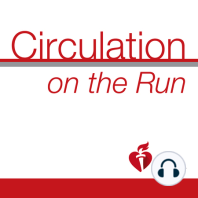18 min listen
Circulation November 10, 2020 Issue
ratings:
Length:
23 minutes
Released:
Nov 9, 2020
Format:
Podcast episode
Description
This week’s episode features author Kazuomi Kario and Associate Editor Wanpen Vongpatanasin as they discuss the article "Nighttime Blood Pressure Phenotype and Cardiovascular Prognosis: Practitioner-Based Nationwide JAMP (Japan Ambulatory Blood Pressure Monitoring Prospective) Study." TRANSCRIPT BELOW: Dr Carolyn Lam: Welcome to Circulation on the Run, your weekly podcast, summary, and backstage pass to the journal and its editors. I'm Dr Carolyn Lam, Associate Editor from the National Heart Center and Duke National University of Singapore. Dr Greg Hundley: And I'm Dr Greg Hundley, Associate Editor, Director of the Pauley Heart Center at VCU Health in Richmond, Virginia. Carolyn, when is the best time to check your blood pressure if you have a home monitoring device? Morning? Afternoon? Nighttime? And what do those nighttime fluctuations infer? Well, we'll hear a lot more in our feature discussion today, but first let's grab a cup of coffee and jump into some of the other papers in the issue. I'm going to start first this week, and my first paper comes from Dr Joe Wu at Stanford University. Carolyn, a quiz. Are all endothelial cells alike? Dr Carolyn Lam: Jeez, Greg. Okay, I'm going to hedge. I bet a lot of them share similarities, but there may be some differences. Dr Greg Hundley: Yes, Carolyn. Dr Wu and his associates perform a series of elegant experiments involving mice, and they found that certain tissue-specific endothelial cells cluster strongly by tissue, like those in the liver or the brain, whereas others from, for example, adipose tissue or the heart have considerable transcriptomic overlap with endothelial cells from other tissues. They identified novel markers of tissue-specific endothelial cells and signaling pathways that may be involved in maintaining their identity, and sex was a considerable source of heterogeneity in the endothelial transcriptome. In addition, they found that markers of heart and lung endothelial cells in mice were conserved in human fetal heart and lung endothelial cells and identified potential angiocrine interactions between tissue-specific endothelial cells and other cell types by analyzing ligand and receptor expression patterns. Dr Carolyn Lam: So interesting, Greg. You especially had me at sex differences. So, what's the take home message? Dr Greg Hundley: Right, Carolyn. So this group discovered a series of transcriptional networks that maintain endothelial cell heterogeneity, and that angiocrine and functional relationships exist between tissue-specific endothelial cells. These findings open the door for future studies that can manipulate these pathways and perhaps modify processes, like atherosclerosis, that impact the endothelium. Dr Carolyn Lam: Wow, that's cool, Greg. Well, from your paper, I'm going to a mechanistic paper too, and the next study really aimed to define cardiac fibroblasts' heterogeneity during ventricular remodeling, as well as the underlying mechanisms that regulate their function, so important questions here. And co-corresponding authors, Drs Prósper and Lara-Astiaso from Clinica Universidad de Navarra in Pamplona in Spain, as well as Dr Lindner from Maine Medical Center Research Institute in Scarborough, Maine in the U.S., and their co-authors, basically characterized cardiac fibroblasts after myocardial infarction using a whole host of very novel techniques like single-cell and bulk RNA sequencing, ATAC sequencing, and functional assays. Swine and patient samples were studied using bulk RNA sequencing. Dr Greg Hundley: Very intriguing. What did they find? Dr Carolyn Lam: They identified and characterized a unique cardiac fibroblast subpopulation that emerged after myocardial infarction in mice. These activated fibroblasts exhibited a clear profibrotic signature expressing high levels of collagen triple helix repeat containing 1 and localized into the scar. Moreover, the absence of this regulator resulted in pronounced lethality due to ventricular r
Released:
Nov 9, 2020
Format:
Podcast episode
Titles in the series (100)
Circulation January 23, 2018 Issue by Circulation on the Run
